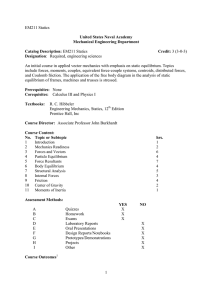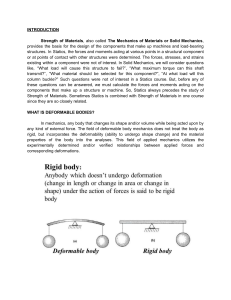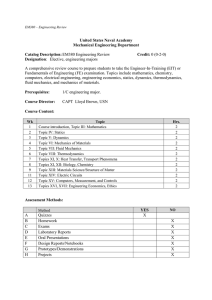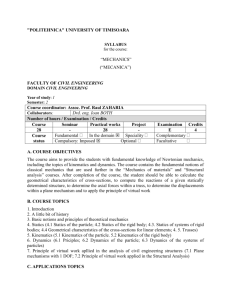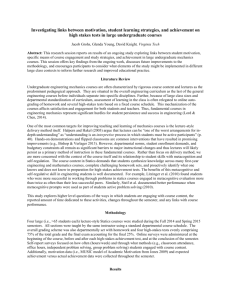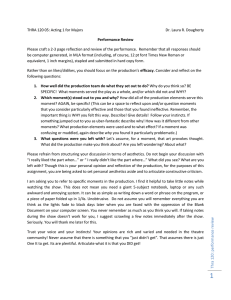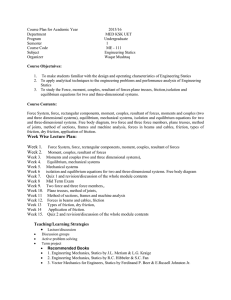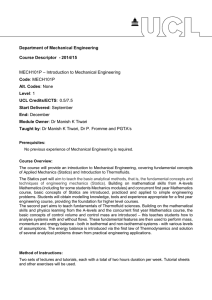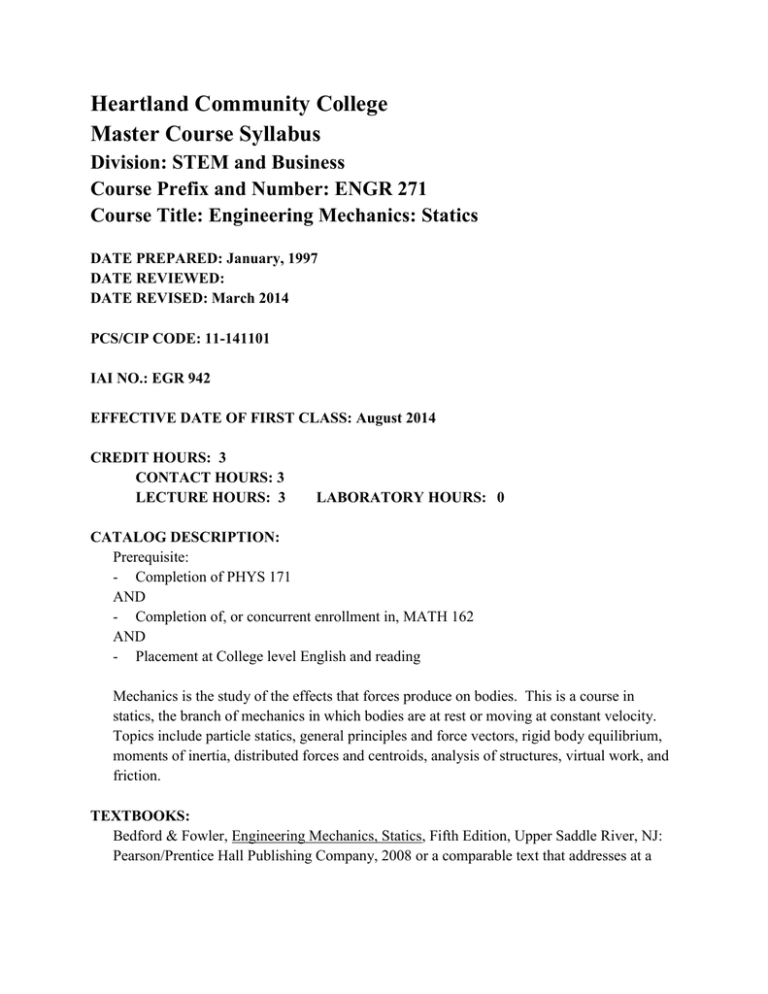
Heartland Community College
Master Course Syllabus
Division: STEM and Business
Course Prefix and Number: ENGR 271
Course Title: Engineering Mechanics: Statics
DATE PREPARED: January, 1997
DATE REVIEWED:
DATE REVISED: March 2014
PCS/CIP CODE: 11-141101
IAI NO.: EGR 942
EFFECTIVE DATE OF FIRST CLASS: August 2014
CREDIT HOURS: 3
CONTACT HOURS: 3
LECTURE HOURS: 3
LABORATORY HOURS: 0
CATALOG DESCRIPTION:
Prerequisite:
- Completion of PHYS 171
AND
- Completion of, or concurrent enrollment in, MATH 162
AND
- Placement at College level English and reading
Mechanics is the study of the effects that forces produce on bodies. This is a course in
statics, the branch of mechanics in which bodies are at rest or moving at constant velocity.
Topics include particle statics, general principles and force vectors, rigid body equilibrium,
moments of inertia, distributed forces and centroids, analysis of structures, virtual work, and
friction.
TEXTBOOKS:
Bedford & Fowler, Engineering Mechanics, Statics, Fifth Edition, Upper Saddle River, NJ:
Pearson/Prentice Hall Publishing Company, 2008 or a comparable text that addresses at a
minimum the topics listed in the Course Outline and that provides students with the
opportunity to achieve the learning outcomes for this course.
RELATIONSHIP TO ACADEMIC DEVELOPMENT PROGRAMS AND
TRANSFERABILITY:
ENGR 271 fulfills 3 semester hours of elective credit for the A.A., A.S. or A.A.S. degrees. It
should transfer to most colleges and universities as an elective course. However, since it is
not part of the General Education Core Curriculum described in the Illinois Articulation
Initiative, students should check with an academic advisor for information about its
transferability to other institutions. This course should articulate as the equivalent of an IAI
baccalaureate major course; refer to the IAI web page for further information at
www.itransfer.org
LEARNING OUTCOMES:
COURSE OBJECTIVES: After successfully completing the course, students should be able to:
1. Identify the type of Mechanics problem.
2. Develop an approach to apply to the problem from a synthesis of multiple strategies.
3. Apply concepts and skills from other courses or disciplines.
4. Incorporating steps 1 through 3, construct a set of formulas/equations. (CT3)
5. Calculate a solution.
6. Evaluate the process (steps 1 through 5) to ensure the appropriateness of the process (e.g.,
does the process satisfy conditions of the application); and refine the process as
necessary. (CT4, PS4)
7. Interpret the final results.
8. Communicate the problem solving process and final results. (CO1)
ESSENTIAL COMPETENCIES:
PS4: Student analyzes the situation, explores different outcomes from multiple frameworks,
applies the appropriate solution, analyzes the results, and refines the solution.
CT4: Students actively reflect on their answer, approach, or solution and act upon those
reflections to improve the final result.
CT3: Students generate an answer, approach, or solution through an effective synthesis of
diverse sources and arguments and provide a rationale.
CO1: Students compose a message and provide ideas and information suitable to the topic,
purpose, and audience.
RANGE OF ASSESSMENT METHODS:
Exams, and may include but are not limited to quizzes, papers, homework, class
presentations.
COURSE/LAB OUTLINE:
1.
Break force vectors into component and combine forces into a resultant.
2.
Analyze forces, unit vectors, components in 3-D
3.
Solve two and three-dimensional force systems by vector and scalar methods.
4.
Apply principles of forces to problems involving structures and friction.
5.
Compute moments and couples.
6.
Evaluate systems in force and moment static equilibrium.
7.
Determine forces on members in a truss, frame, and pulley.
8.
Apply friction laws to direction, wedges, belt, disk, incline.
9.
Determine the centroid of areas.
10.
Determine moments of inertia.
11.
Determine forces and moments by virtual work.
METHOD OF EVALUATION:
Instructors may determine the most appropriate methods of evaluation for their course.
These methods of evaluation include exams and may include but are not limited to quizzes,
papers, homework, class presentations.
Grading Scale
90-100%
80-89%
70-79%
60-69%
Below 60%
A
B
C
D
F
REQUIRED WRITING AND READING:
Students are expected to read the material in the textbook for each section studied which is
approximately 350 pages for the semester. Students are expected to explain solution
processes, describe solutions analytically/graphically, and interpret the answer in the context
of the problem. Instructors may incorporate writing assignments as part of the course grade,
in keeping with learning outcomes. Other reading assignments may be assigned, possibly in
conjunction with writing assignments.

